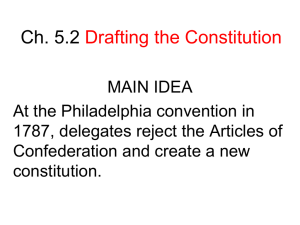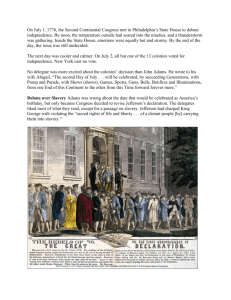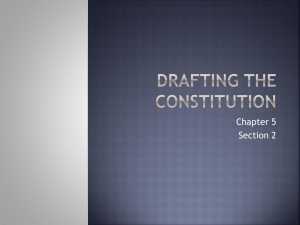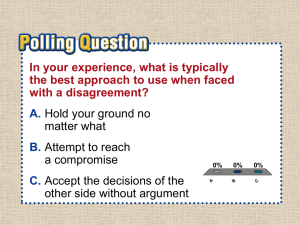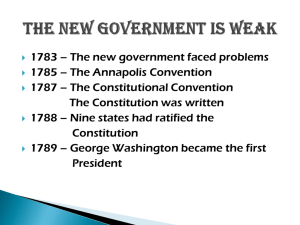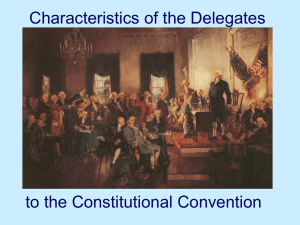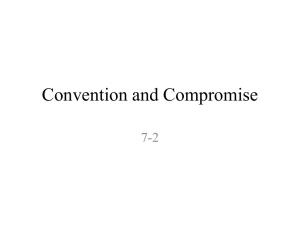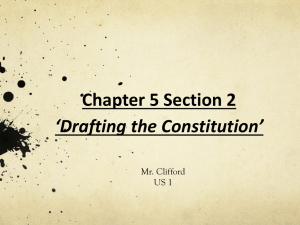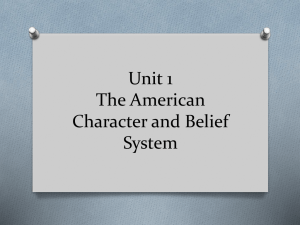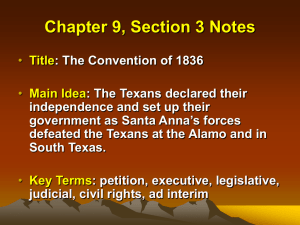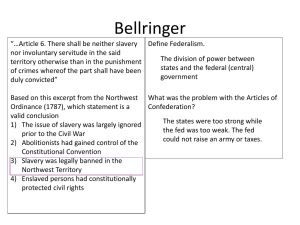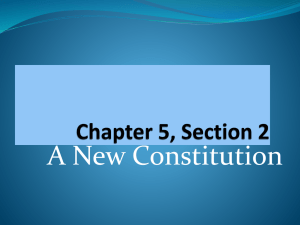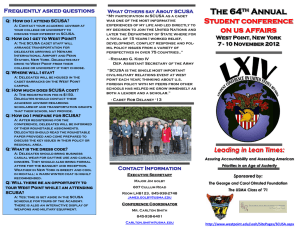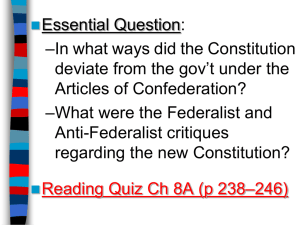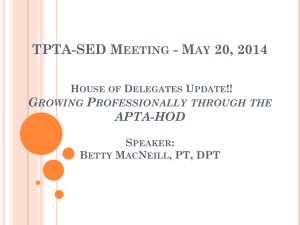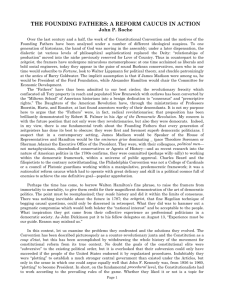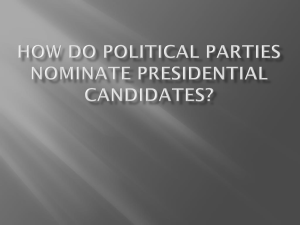Shay Rebellion Powerpoint
advertisement
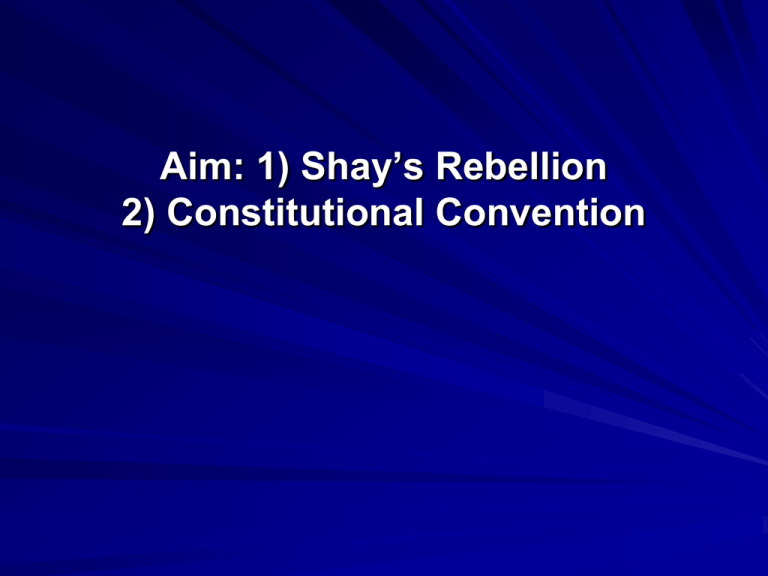
Aim: 1) Shay’s Rebellion 2) Constitutional Convention Shay’s Rebellion Background Springfield, Massachusetts-Summer of 1786 Massachusetts government wanted to pay off debt and have a sound currency Between 1780 and 1786, legislature levied 1.9 million pounds in taxes Burden of taxes falls heavily on farmers Most farmers already in heavy debt Faced possible loss of their land for failure to pay debts and state taxes Daniel Shay led rebellion Shay was a veteran of the Revolutionary War Massachusetts government fails to issue paper money or pass other measures to help debt ridden farmers Shay and his followers storm the courts in Springfield to prevent courts from meeting and to prevent seizure of their land Governor James Bowdoin dispatched army to put down rebellion Rebels attack army 1,000 people arrested Shay fled to Vermont Reaction to the Rebellion Governor Bowdoin-Must follow laws or America would descend into “A state of anarchy, confusion, and slavery.” Thomas Jefferson- (Anti-Federalist)- “A little rebellion now and then is a good thing. The tree of liberty must be refreshed from time to time with the blood of patriots and tyrants.” George Washington- “What, gracious God, is man that there should be such inconsistency and perfidiousness in his conduct? We are fast verging to anarchy and confusion!” Importance of the Rebellion Massachusetts appealed to Congress for help but legally Congress could do little National government needed to be strengthened Need for uniform economic policies Protect property owners from governments infringing on their rights Revolutionary War fought on the idea of democracy. Was that idea now out of control? Does private liberty endanger national safety? “Mobacracy” - Unchecked power in the hands of the people - How mobs scare government leaders Annapolis Convention Famous Americans who attended-James Madison, Alexander Hamilton, and John Marshall Recognize need for a stronger national government Meet in September 1786- delegates only from six states – Better ways to regulate interstate and international commerce – Hamilton proposes another gathering in Philadelphia Every state except Rhode Island sent delegates to Philadelphia Convention starts in May 1787 Delegates do away with Articles of Confederation and decide to draft a new constitution Constitutional Convention Starts on May 25, 1787 55 Delegates George Washington-Presiding Officer Other famous Americans include James Madison, George Mason, and Ben Franklin (81 Years Old, Author of Treaty of Paris 1783) Most delegates came from wealth Exception is Alexander Hamilton Half the delegates had a college education Only 1/10 of 1 percent of Americans attended college 22 served in Revolutionary War To allow for free and open debate, meeting took place in private Madison took careful notes-not published until 1840 when last delegate died The Constitution- a “Four Act” Drama Act One- Alternate Plans to the Articles of Confederation Act Two- Great Compromise Act Three- Ratification Process Act Four- Bill of Rights CC has also been called the “Miracle in Philadelphia” Issues Structure of the new national government Power of the state governments National security vs. individual liberty and freedom Structure of Government 3 branches with a strong central government “Power of the Purse” belonged to Congress. Did not have to ask States for permission to raise or levy taxes States prohibited from infringing on people’s rights Delegates rejected Hamilton’s idea of President and Senators serving for life “Rich and well born must rule for the masses who seldom judge or determine right.” George Mason-”The key to a stable, effective republican government was finding a way to balance the competing claims of liberty and power.” Virginia Plan Class Reading Under this plan, what happens to state government? How is Representation decided? What is meant by the word faction(s)? Why was it important to extend the sphere? Virginia vs. New Jersey Plan Under Constitution, national government had to be stronger than state governments Caused a heated debate-balance of power between federal and state governments and big vs. small states Virginia Plan James Madison 2 house legislature State’s population determined representation in each house Small states fear big states like Virginia, Massachusetts, and Pennsylvania would dominate NJ Plan William Patterson One house Congress States cast one vote This issue threatens to ruin the convention. Many delegates ready to walk out. Solution is Great Compromise Great Compromise Roger Sherman Connecticut Compromise – 2 House legislature – Senate-2 from each state, 6 year term, chosen by state legislature. 17th Amendment in 1913 allows for direct election of senators – HOR-determined by state’s population, 2 year term, chosen by the people Election of the President Electoral College Number of electors determined by a state’s number in the HOR plus 2 senators Today- 270 Electoral Votes out of 538 needed to elect the President Originally, electors cast two ballots- 1st place-President, 2nd place-Vice President 12th Amendment makes President and VP a ticket If no candidate received a majority of votes, election would be decided or “thrown” into the HOR Senate would chose VP Is it possible for a candidate to win the popular vote but lose in the EC? Yes, has happened four times in our history Debate over slavery Words slaves and slavery do not appear in Constitution Institution of slavery divided delegates North-Slaves should be counted towards states share of federal taxes 3/5 Compromise-3/5 of “all other persons” (slave population) will count towards representation in the HOR and the Electoral College Constitution prohibited the abolishment of slavery until 1808 Constitution allowed for fugitive slave laws Slavery in the Constitution South Carolina delegates were the major voice to keep slavery 170,000 slaves came to Georgia and SC between 1787 and 1808 Constitution gave national government no power to interfere with slavery in the states 3/5 Compromise gave southern states tremendous political power Between 1788 and 1848, 12 of the 16 Presidents were southern slaveholders Judiciary System Main job was to settle disputes under the laws and treaties of United States No such system under AOC Supreme Court “Inferior Courts”-Federal Courts Judges to both would be appointed by President Supreme Court judges serve for life Ratification Last convention session took place on September 17, 1787 Franklin urges delegates to sign 39 of 45 remaining delegates signed it Sent to states for ratification

